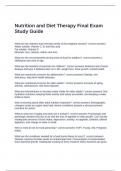Nutrition and Diet Therapy Final Exam
Study Guide
What are the vitamins and minerals needs of the pregnant woman? correct answers
Water soluble: Vitamin C, B, and folic acid
Fat soluble: Vitamin D
Minerals: Iron, calcium, iodine, and zinc.
What are the recommended serving sizes of food for toddlers? correct answers 1
tablespoon per year of age.
What are the benefits of exercises for children? correct answers Reduced risk of heart
disease and type 2 diabetes later on in life, weight loss, bone growth, mental health.
What are nutritional concerns for adolescents? correct answers Obesity, iron
deficiency, long term health diseases
What are nutritional concerns for older adults? correct answers Anorexia of aging,
arthritis, osteoporosis, and heart disease.
What are interventions to increase water intake for older adults? correct answers Oral
hydration solutions, keeping fluids nearby and easily accessible, and keeping a water
bottle at hand.
Why is learning about older adult nutrition important? correct answers Demographic
changes create an urgent need and chronic conditions present a strong economic
incentive for action.
What is anorexia of aging and what can it include? correct answers Psychologic and
pathologic disease that has to do with the loss of appetite in older people. Can include
Inadequate amounts of food intake, depression, anxiety, no appetite, isolation, altered
digestion, and change in taste or smell.
Who is most at risk for food poisoning? correct answers YOPI. Young. Old. Pregnant.
Infant.
What are the conditions needed for a food borne illness to occur? correct answers
Disease causing microbe needs to contaminate food. Consumption of contaminated
food, bacterial growth, inadequate cooking of food, moisture where bacteria can grow.
, What is Norovirus? correct answers Most common food borne disease in the U.S. and
is the common flu.
How does food borne illness occur? How are they able to grow? correct answers Food
contamination or the spread of disease. Thoroughly cooking food, washing hands, and
not leaving food out.
What are environmental pollutants? correct answers Chemical poisons, heavy metals,
chemical products.
What are examples of FDA approved food additives? correct answers Pesticides,
emulsifiers, color additives, thickeners, binders, flavor enhancers, stabilizers. They
maintain or improve safety and freshness, maintain and improve nutritional value, and
improve fast, texture, or appearance.
When would you use enteral or venous routes for nutrition? correct answers Enteral:
Used when a client cannot consume adequate nutrients and calories orally, but GI
system is still functioning.
Parenteral: Used when the clients GI system isn't functioning properly or when a client
cannot consume sufficient nutrients orally or enterally.
What are the types of formulas used for enteral and parenteral nutrition? correct
answers Intact and elemented formulas.
What would be included in an exercise plan for weight loss? correct answers Cardio,
strength training, and flexibility exercises.
What are the classifications for BMI? correct answers underweight: 18.5 or less
normal: 18.5- 24.9
overweight: 24.9-29.9
obese: 29.9-34.9
What are the consequences of obesity? correct answers Cardiovascular disease, type
2 diabetes, musculoskeletal disorders, cancer, mental health disease, sleep apnea,
gallbladder disease, high LDL cholesterol and blood pressure, stroke.
What can an energy imbalance lead to? correct answers Weight gain, plaques can
build up on arteries, blood pressure and LDL levels can increase, diabetes, and cancer.
What are the minimum percent of macronutrients that should be included in a weight
loss diet? correct answers
What is hyperglycemia? correct answers Excess of glucose in the blood stream, often
associate with diabetes mellitus. If type 2, then not enough insulin produced. If type 1,
then not enough insulin consumed. Increases thirst and urination.




